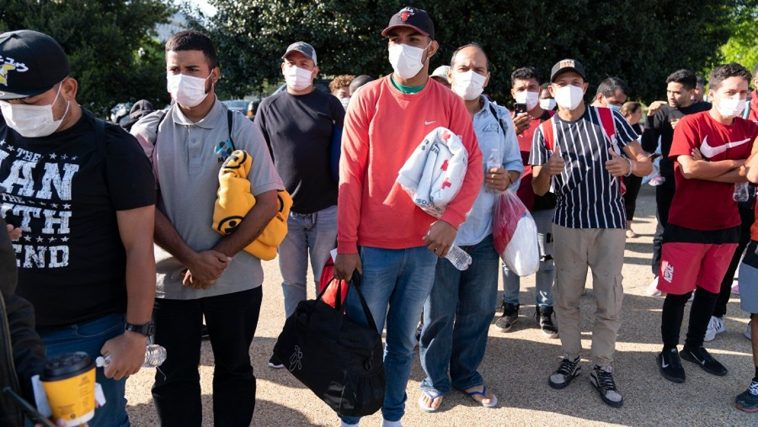LISTEN HERE:
Texas has initiated the transportation of migrants to cities abundantly adopting sanctuary status, commencing with a flight that touched down in Chicago this Tuesday, according to our sources. This new approach signifies a transition from Governor Greg Abbott’s previous measures that involved vehicular transfer of migrants, aimed at offloading the demanding circumstances faced by the border state.
The inaugural flight departed from El Paso on Tuesday afternoon, ferrying 120 migrants before its evening arrival at Chicago’s O’Hare Airport. This information was confirmed by inside sources from Governor Abbott’s office. It was clarified that the migrants taking the flight had acquiesced to it, signing voluntary waivers, similar to the process followed during their earlier bus journeys.
This change of strategy comes as a countermeasure against the legal impediments Chicago posed to the bussing efforts. Essentially, Chicago had initiated legal actions targeting the firms involved in the transportation of these migrants.
Abbott’s transportation strategy for migrants took shape in April 2022, initially involving bus transfers towards Washington, D.C. This modus operandi was subsequently expanded to embrace other urban locations renowned for their ‘sanctuary’ regulations, restricting cooperation with federal immigration authorities.
Speaking on the matter this week, Governor Abbott’s office stated that over 82,900 migrants have been transferred via bus to cities such as Washington, D.C., New York City, Chicago, Philadelphia, Denver, and Los Angeles. Governor Abbott underscored that this protocol offers essential respite to border towns and pledged its continuation until the border secures under the Biden administration.
Yet, such actions have not been without detractors; critics of Abbott’s policy call it an ‘illicit’ political maneuver. Mayors of both Chicago and New YORK City have vocally condemned this strategy, largely expressing disapproval over Abbott’s bus initiative.
Specifically, Mayor Brandon Johnson of Chicago accused Governor Abbott of instigating nationwide disorder earlier this week. According to Johnson, the problem extends beyond the response from the city of Chicago and enters into the realm of actions taken by the Texan Governor.
Johnson portrayed the unsettling image of Texas officials shipping off families in distressing conditions, then depositing them into cities already grappling with issues of homelessness and inadequate mental health support. He vocally called on the Texas Governor to reflect on his actions, and the ensuing disarray spread across the nation.
In a rebuttal to Johnson’s allegations, Abbot’s press secretary, Andrew Mahaleris, claimed that Johnson’s statements were ‘blatant untruths’. His argument rested on a challenge towards Johnson, stating that if the mayor genuinely cared for these migrants, he would cease from disseminating misleading information.
Mahaleris continued his defense by proposing that instead of lambasting Texas for the relatively small groups of migrants sent to his sanctuary city, Mayor Johnson should instead pressure President Biden to ensure prompt action towards the securing of the border, a crucial task that he believed President Biden has been inadequate in executing till now.
Aside from the political back-and-forth, the situation at the southern border persists, with alarmingly high numbers of migrants encountered. This week, a new daily record was set as border officials came across over 12,600 migrants within a single 24-hour frame.
Sources within the Customs and Border Protection relayed to our team that the overall count of migrant encounters in December already surpassed 190,000. These figures could possibly set a new monthly record surpassing the previous peak of 269,000 recorded in September.
Our sources informed us that border patrol agents were averaging around 10,000 migrant encounters each day. Simultaneously, sources from Mexico indicated an incoming surge of migrants that will add to the existing crisis.
The debate on how to handle the inflow of migrants at the Texan border rages on and has become a cornerstone of the political discourse in affected cities and beyond. Balancing the need to provide for their own citizenry and fulfilling the humanitarian call to assist migrants poses a significant tense issue that American cities are dealing with at the moment.
While policymakers continue navigating this multifaceted issue, citizens too find themselves entangled in the geopolitical and humanitarian facets of the debate. With Governor Abbott’s latest move, it seems that the pendulum has swung towards a more direct involvement of sanctuary cities in the migrant crisis.
Ultimately, the unfolding of these events rests heavily on the decisions made by state governors, city mayors, and the federal government, which are coping with the increasing demands placed on their jurisdictions by the ongoing migration influx.


